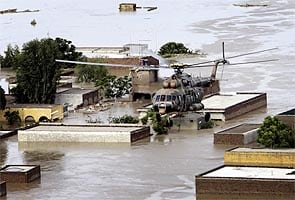
Nowshera:
A Pakistani official said the death toll from massive floods in the northwest has risen to 1,100 people.
Disaster management official Adnan Khan said on Sunday that the death toll could rise even higher since there are areas in Khyber-Pakhtoonkhwa province that rescue workers have not been able to access.
Authorities were struggling on Sunday to save more than 27,000 people still trapped by the flooding that has plagued the northwest in recent days following heavy monsoon rains.
Khan said more than 20,000 people have been rescued so far.
The effort has been aided by a slackening of the monsoon rains that have caused the worst flooding in decades in Khyber-Pakhtoonkhwa province.
But as flood waters have started to recede, authorities have begun to understand the full scale of the disaster.
In Nowshera city, where water levels were dropping on Sunday, some people were slowly making their way back to their houses.
Shair Dad, a timber shop owner, said his business had been badly affected by the floods.
"I haven't covered my losses in ten years, we are buying this wood on credit, I don't know how I will be able pay it back," he said on Sunday.
Mujahid Khan, the head of rescue services for the Edhi Foundation, a private charity, said the worst hit areas have been the districts of Swat and Shangla, where more than 400 people have died.
Authorities have deployed 43 military helicopters and over 100 boats to try to rescue some 27,300 people still trapped by the floods.
The military has deployed 30,000 army troops who had evacuated 19,000 trapped people by Saturday night, said an army spokesman.
The army was also distributing relief on Sunday with one officer stating he had "four tonnes of food for distribution" at a relief point in Dera Ismail Khan.
However the United Nations has estimated that one (m) million people nationwide have been affected by the floods, and the scale of the disaster has strained the resources of a government already grappling with a faltering economy and a brutal war against the Taliban.
The floods have caused an acute shortage of fruits and vegetables in the northwest because many of the hardest hit areas were the key centres of production, officials said.
The threat of disease now also looms as well, some evacuees have already arrived in camps with fever, diarrhoea and skin problems.
A variety of nations and aid organisations have begun to mobilise a response to the flood disaster.
The US delivered 380-thousand food packages, four rescue boats and two water filtration units to the Provincial Disaster Management Authority, said a spokesman for the Provincial Disaster Management Authority.
The US Embassy in Islamabad has also announced it will provide 12 prefabricated steel bridges to temporarily replace some of the spans damaged by the water.
Floodwaters were receding in the northwest, Pakistani officials said, but fresh rains were expected to lash other parts of the country in the coming days.
Disaster management official Adnan Khan said on Sunday that the death toll could rise even higher since there are areas in Khyber-Pakhtoonkhwa province that rescue workers have not been able to access.
Authorities were struggling on Sunday to save more than 27,000 people still trapped by the flooding that has plagued the northwest in recent days following heavy monsoon rains.
Khan said more than 20,000 people have been rescued so far.
The effort has been aided by a slackening of the monsoon rains that have caused the worst flooding in decades in Khyber-Pakhtoonkhwa province.
But as flood waters have started to recede, authorities have begun to understand the full scale of the disaster.
In Nowshera city, where water levels were dropping on Sunday, some people were slowly making their way back to their houses.
Shair Dad, a timber shop owner, said his business had been badly affected by the floods.
"I haven't covered my losses in ten years, we are buying this wood on credit, I don't know how I will be able pay it back," he said on Sunday.
Mujahid Khan, the head of rescue services for the Edhi Foundation, a private charity, said the worst hit areas have been the districts of Swat and Shangla, where more than 400 people have died.
Authorities have deployed 43 military helicopters and over 100 boats to try to rescue some 27,300 people still trapped by the floods.
The military has deployed 30,000 army troops who had evacuated 19,000 trapped people by Saturday night, said an army spokesman.
The army was also distributing relief on Sunday with one officer stating he had "four tonnes of food for distribution" at a relief point in Dera Ismail Khan.
However the United Nations has estimated that one (m) million people nationwide have been affected by the floods, and the scale of the disaster has strained the resources of a government already grappling with a faltering economy and a brutal war against the Taliban.
The floods have caused an acute shortage of fruits and vegetables in the northwest because many of the hardest hit areas were the key centres of production, officials said.
The threat of disease now also looms as well, some evacuees have already arrived in camps with fever, diarrhoea and skin problems.
A variety of nations and aid organisations have begun to mobilise a response to the flood disaster.
The US delivered 380-thousand food packages, four rescue boats and two water filtration units to the Provincial Disaster Management Authority, said a spokesman for the Provincial Disaster Management Authority.
The US Embassy in Islamabad has also announced it will provide 12 prefabricated steel bridges to temporarily replace some of the spans damaged by the water.
Floodwaters were receding in the northwest, Pakistani officials said, but fresh rains were expected to lash other parts of the country in the coming days.
Track Latest News Live on NDTV.com and get news updates from India and around the world

